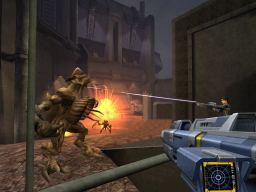
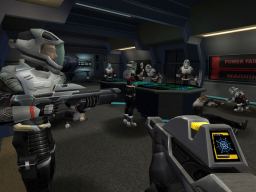
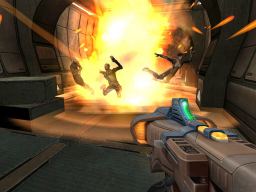
For years the Star Trek franchise was synonymous with extremely poor PC gaming.
A slew of reasons ranging from bad writing, poor graphics, to substandard
gameplay was the chagrin of devout gamers and Trek fans alike. Things changed
for the better a few years ago when the brilliant release Star Trek: Elite Force
hit the market. Not only was the FPS game a hit, it actually encompassed the
best traits of Star Trek throughout its core without sacrificing any of its
intense gameplay. Two years later, its sequel Star Trek: Elite Force II has hit
the shelves, but does this game live up to its predecessor? For more information
on this latest jaunt into the Trek universe, check out the full review here at
The Laser.
There are two types of people in the world:
those that love Star Trek, and those that don't know any better. The rich
tapestry of sci-fi created by the late Gene Rodenberry has lasted an amazing 40
years, spanning 5 different TV series, 10 feature length films, scores of novels
and comic books, and even a Saturday morning animated cartoon. The Star Trek
legacy has successfully transcended and conquered every form of media except for
one: PC gaming. Although there has been a quite a few successful titles over the
past several years, they've been eclipsed by the slew of crappy games that have
perforated the video gaming market (check out Star Trek: Hidden Evil if you
don't believe us). One of the first games to actually break the cycle of poor
Trek gaming was Star Trek: Elite Force, developed by the creative geniuses at
Raven Software (the same group that brought us last years' incredible Jedi
Knight Outcast). Elite Force successfully interwove classic FPS gaming with Trek
styled writing and execution, providing fans of the sci-fi series (as well as
gamers) with an incredibly dynamic PC game. After two long years, we finally
have the chance to revisit the FPS Star Trek world with Elite Force II.
Unfortunately, the same Gene Rodenberry Trek-styled magic that was captured by
the original release just didn't exist with this latest game.
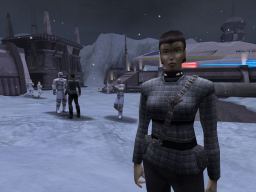 Like
the original game, Star Trek: Elite Force II follows the exploits of the
specialized 'Hazard Team' created by Captain Janeway and Lt. Tuvok during their
Delta Quadrant adventures (as chronicled in the Star Trek: Voyager TV series).
After the final battle against the Borg (as seen in the series finale of the TV
show), the Starship Voyager and her crew find themselves back in Federation
space, safe and sound. Of course this puts a hamper on the activities of Lt.
Alexander Munro and his specialized Hazard Team, since there isn't a pressing
need for their brand of extreme combat and specialized war tactics. The team
find themselves quickly re-assigned along with the rest of Voyager's crew,
returning a sense of normality to their lives (even if it is a tad bit boring
compared to their adventures in the Delta Quadrant). Several years pass by, and
once again it seems that StarFleet and the Federation have a use for the Hazard
Team after all. Several Starships have come under attack recently, and Captain
Picard has been ordered to investigate. Before the Enterprise-E leaves for deep
space in search of answers to the mystery at hand, Picard enlists the services
of Lt. Munro and his exceptional teammates. With the remnants of the Hazard Team
together again (along with a few new faces), they must not only solve the
mystery of the attacks, but also protect the Alpha Quadrant from the
resurrection of an ancient evil.
Like
the original game, Star Trek: Elite Force II follows the exploits of the
specialized 'Hazard Team' created by Captain Janeway and Lt. Tuvok during their
Delta Quadrant adventures (as chronicled in the Star Trek: Voyager TV series).
After the final battle against the Borg (as seen in the series finale of the TV
show), the Starship Voyager and her crew find themselves back in Federation
space, safe and sound. Of course this puts a hamper on the activities of Lt.
Alexander Munro and his specialized Hazard Team, since there isn't a pressing
need for their brand of extreme combat and specialized war tactics. The team
find themselves quickly re-assigned along with the rest of Voyager's crew,
returning a sense of normality to their lives (even if it is a tad bit boring
compared to their adventures in the Delta Quadrant). Several years pass by, and
once again it seems that StarFleet and the Federation have a use for the Hazard
Team after all. Several Starships have come under attack recently, and Captain
Picard has been ordered to investigate. Before the Enterprise-E leaves for deep
space in search of answers to the mystery at hand, Picard enlists the services
of Lt. Munro and his exceptional teammates. With the remnants of the Hazard Team
together again (along with a few new faces), they must not only solve the
mystery of the attacks, but also protect the Alpha Quadrant from the
resurrection of an ancient evil.
All in all, we found the game to be
entertaining, both as a First-Person Shooter and as a Star Trek based game. The
graphic design was probably the best aspect of the game, taking advantage of the
newly enhanced Quake III Arena engine. Every visual found in Elite Force II was
incredibly detailed, giving us not only realistic terrain and interiors but also
some extremely life-like in-game character models. Fans will definitely take
note of the improved 'skins' found in the game, modeled off of some of the most
popular races and species found in the Trek universe, including the machine-like
Borg, the warrior race known as the Klingons, the unscrupulous Ferengi, the blue
skinned Andorians, the conniving Romulans, the animalistic Nauscicans, and even
the mild mannered Denobulans. Players will not only run into these familiar Trek
faces, but also hordes of other new alien races from the farthest reaches of the
galaxy as you explore the 70 levels of Elite Force II. Not only that, but
players will get to use several new and upgraded Hazard Team weapons not found
in the original version, including the Quantum Torpedo Burst Rifle, the
Radiation Disruptor Pistol, and even the dreaded Klingon Bat'leth. The new
weapons come in handy during the 20 plus hours of intense First-Person Shooter
action that makes up the base of the gameplay, keeping gamers on edge for quite
some time. Fans of the genre will definitely enjoy the combat, regardless of
whether you're a Trek fan or not.
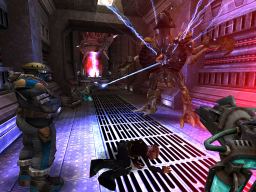 Although
many Star Trek elements surround Elite Force II, the game just didn't pull off
the same effect as the original. Two years ago, Elite Force did an excellent job
of capturing the essence of a Star Trek episode. Not only was the plot line of
the game coherent and well written, the pacing of the game went along the same
lines as a TV episode of a Star Trek episode (intermixing several 'acts' made up
of cinematics with the regular gameplay). Elite Force actually made us feel like
we were in an episode of Star Trek: Voyager, letting us mingle with Captain
Janeway and her Starfleet crew. Elite Force II on the other hand seemed
disjointed and 'stuck-together', for lack of a better term. The plot lines
surrounding the gameplay (again, dealing with resurrected bad guys bent on
galaxy wide chaos) seemed contrived and hastily put together, lacking the
Roddenberry finesse that inspired the original game. Although the A.I. of the
game has been greatly improved upon (allowing for better interaction between the
gamer and the computer opponents and allies found in the game), the team aspect
was greatly diminished when compared to the original Elite Force release. On
more than one occasion we found ourselves curiously going at a mission alone,
with the rest of the Hazard Team hanging back to 'protect the area', or for some
other dumb reason (one of your teammates actually asks you during the game why
your character always runs ahead by himself). Even some of the weapons found in
the game had an non-Star Trek quality to them, mimicking your standard FPS
weapons found in any game, but having a more sci-fi sounding name. The last
oddity to capture our attention was the inane side-plot role play aspect that
allowed you to supposedly change the direction of the game with your in-game
choices: in reality, it only gave players the chance to view a slightly
different personal outcome that had little to do with the meat of the game.
Although
many Star Trek elements surround Elite Force II, the game just didn't pull off
the same effect as the original. Two years ago, Elite Force did an excellent job
of capturing the essence of a Star Trek episode. Not only was the plot line of
the game coherent and well written, the pacing of the game went along the same
lines as a TV episode of a Star Trek episode (intermixing several 'acts' made up
of cinematics with the regular gameplay). Elite Force actually made us feel like
we were in an episode of Star Trek: Voyager, letting us mingle with Captain
Janeway and her Starfleet crew. Elite Force II on the other hand seemed
disjointed and 'stuck-together', for lack of a better term. The plot lines
surrounding the gameplay (again, dealing with resurrected bad guys bent on
galaxy wide chaos) seemed contrived and hastily put together, lacking the
Roddenberry finesse that inspired the original game. Although the A.I. of the
game has been greatly improved upon (allowing for better interaction between the
gamer and the computer opponents and allies found in the game), the team aspect
was greatly diminished when compared to the original Elite Force release. On
more than one occasion we found ourselves curiously going at a mission alone,
with the rest of the Hazard Team hanging back to 'protect the area', or for some
other dumb reason (one of your teammates actually asks you during the game why
your character always runs ahead by himself). Even some of the weapons found in
the game had an non-Star Trek quality to them, mimicking your standard FPS
weapons found in any game, but having a more sci-fi sounding name. The last
oddity to capture our attention was the inane side-plot role play aspect that
allowed you to supposedly change the direction of the game with your in-game
choices: in reality, it only gave players the chance to view a slightly
different personal outcome that had little to do with the meat of the game.
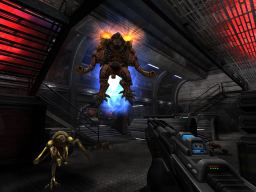 Even
though Ritual Software might not have done as great a job with Elite Force II as
Raven Software did with the original release, they weren't complete slouchers
either. For example, the developers were able to wrangle up the largest amount
of ex-Trek voiceover talent ever for a PC title. The cast includes series stars
Patrick Stewart as Captain Picard and Tim Russ as Lieutenant Tuvok, as well as a
host of regular actors from various incarnations of the show, including Dwight
Shultz (Lieutenant Barclay), Robert O'Reilly (Chancellor Gowron), and Jeffery
Combs (Wayoun). The developers also enhanced the Multiplayer portion of the
game, adding some highly detailed maps found in the single player part of the
game, as well as creating several new maps for first-person action fanatics to
rejoice in. The standard fare of Capture the Flag, Deathmatch, and Team
Deathmatch are of course included: the special treat though comes in the form of
a new Timebomb cooperative game, forcing teams to fight over one bomb that needs
to be successfully detonated in enemy territory in order to win.
Even
though Ritual Software might not have done as great a job with Elite Force II as
Raven Software did with the original release, they weren't complete slouchers
either. For example, the developers were able to wrangle up the largest amount
of ex-Trek voiceover talent ever for a PC title. The cast includes series stars
Patrick Stewart as Captain Picard and Tim Russ as Lieutenant Tuvok, as well as a
host of regular actors from various incarnations of the show, including Dwight
Shultz (Lieutenant Barclay), Robert O'Reilly (Chancellor Gowron), and Jeffery
Combs (Wayoun). The developers also enhanced the Multiplayer portion of the
game, adding some highly detailed maps found in the single player part of the
game, as well as creating several new maps for first-person action fanatics to
rejoice in. The standard fare of Capture the Flag, Deathmatch, and Team
Deathmatch are of course included: the special treat though comes in the form of
a new Timebomb cooperative game, forcing teams to fight over one bomb that needs
to be successfully detonated in enemy territory in order to win.
To wrap things up, Star Trek: Elite Force II
was a decent game when compared to other titles within the FPS genre. Non only
was the action in the game fast paced and non-stop, the graphics were incredibly
detailed and simply beautiful to look at. The Star Trek aspect of the game was
lacking, however. This included the non-Trek like plot surrounding the game, the
weapons used, and even the pacing. Again, it seemed as if the game was created
first, with the Star Trek moniker attached as an afterthought. Though a
disappointing follow up to the critically acclaimed original Elite Force game,
this latest release isn't without its merits. Unfortunately, this might be the
last hurrah for at least a semi-decent Trek game since game publisher Activision
is currently at odds with the franchise owner Viacom over supporting its titles
and Star Trek as a whole. So, enjoy the adventures of the 23rd century while you
can, even if they're not the best.
> Related Reviews
Star Trek: Elite Force (PC)
Star Trek: Armada
II (PC)
Star
Trek: Bridge Commander (PC)
Star Wars: Jedi Knight II (PC)

